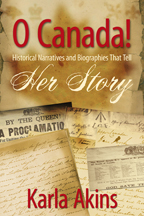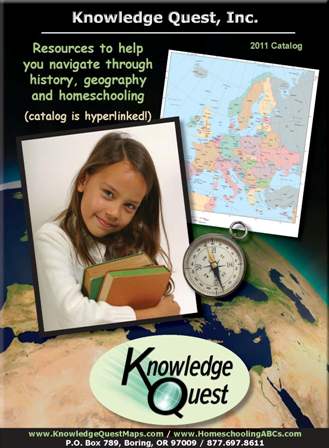|
January 3, 2006 - by Terri Johnson, author of Homeschooling ABCs (www.homeschoolingabcs.com ) - dedicated to helping new homeschoolers gain the confidence and the necessary skills to
successfully teach their children at home.
Geography...
The Lost Piece of the History Puzzle
Macedon… Carthage… Pompeii… Gaul… These are places of historical significance, but you will no find them on any
globes or current maps around your home. Why? It is because they no longer exist. Does this mean, then, that we do
not have to bother with knowing their locations?
To the contrary. The “where” of history is just as critical to the story as the “who” and “when”. To close our eyes
to geography while studying history is very similar to learning math without manipulatives. It can be done, but it
leaves holes in the complete picture, very much like putting together a puzzle without all the pieces. History is
like a puzzle - the way that it all fits and connects together. People, events, artifacts and literature are all
pieces in that puzzle. And so are the places.
Yet geography is a subject that many parents feel inadequate to teach. We often do not remember much from our own
geography lessons and a sincere question from a curious, up-turned face, such as “Where is Gaul?” can feel quite
intimidating. It can be challenging enough to find Green Bay on a map, much less Gaul which no longer exists.
Are you like me when reading a fascinating book? You keep your thumb on the map page of the book so that you can
continue to refer back to it as the story unfolds. For me, it does not matter if it is Middle Earth or Mitford; I
like to see where the characters are going. The story seems to come more alive for me when I can visualize the
movements of the characters and the places that they frequent and travel.
It is the same with history. The story simply makes more sense when you know the locations and movements of the
main characters. Maps and the study of geography alongside history will
actually give you clues as to why events happened as they did. It is like the piece of the puzzle that helps the
whole picture to make sense.
Have you ever wondered why Hannibal and his elephants were able to sneak up and surprise the
Romans so completely?
And why was Greece, such a small country, able to defend themselves against the repeated attacks of the mighty
Persians?
Have you ever wondered about Jonah? He is told by God to go and preach in Nineveh, so why does he set sail for
Tarsus instead?
You have heard that Alexander the Great conquered the whole known world. Exactly how large was this
territory?
These are just a few mysteries from the ancient world, but there are mysteries like this throughout history and
they can only be solved through studying geography. Here are a few more from medieval times:
Why did the Byzantines consider themselves Roman and yet speak Greek instead of Latin?
Why was printing with movable type invented in the Rhineland and what does this have to do with the fall of
Constantinople in that same year?
Have I peaked your curiosity a little? The joy of homeschooling is in finding these answers for yourself, but I
will go over a couple of these with you in a little bit.
First, here are some statistics from a survey done by National Geographic:
1. 1 in 10 young Americans could not locate his country on a blank map of the world.
2. Only 13% of young Americans could find Iraq on a map of the Middle East/Asia.
3. The majority of the young people surveyed knew that the Taliban and Al-Qaeda were based in Afghanistan, but only
17% could find that country on a world map.
So how does a home-educating parent incorporate geography into a history lesson? With a few simple tools and
resources on hand, the task can become quite painless, even enjoyable. One key to remember, however, is that it is
perfectly acceptable to learn geography alongside your students. You do not have to have all the information or
answers ready in advance. Investigating the answers together can be a rewarding and bonding experience.
Before reading an historical account, whether from an encyclopedia, a biography or a work of literature, make sure
that you have on hand a globe, a wall map and an historical atlas. Other helpful tools include outline maps (preferably historically based) and a timeline (any format will do - wall, book or computer software). You may be wondering why
a timeline is recommended for incorporating geography into history when this tool focuses more on the “when” aspect
of history? A timeline will allow your student to see what was happening in other parts of the world at the same
time as the event that he is studying.
Okay, now you are ready with your supplies, so how do you do it? Let us take for our example the Punic Wars between
Rome and Carthage. After reading about this event in your history book, you will want to go to your wall map to see
where in the world this war took place. Next you go to the globe to get a better perspective, because a globe is
not distorted like a flat map. As your student touches the upper boundary of Italy, he notices something - raised
mountains. You tell him that those are the Alps - the highest mountain range in Europe. He is beginning to
understand why that wall of mountains provided the Romans with a false sense of security on their northern border.
Really, why would the Carthaginians travel all this way over land, when they are masters of the sea? As he begins
to color his outline map, he can understand further still why all
Roman eyes were to the south and the sea - the most direct attack route from Carthage. Suddenly, he begins to
understand the brilliantly executed plan of Hannibal who led his elephant army right into the middle of Italy
unchallenged. The geography piece of the puzzle has been placed.
Here is another example. You probably know the story of Jonah. Jonah is told by God to go to Nineveh to preach
repentance and the forgiveness of sins. Instead, he goes on a deep sea adventure. Why? First of all, Nineveh is
part of the Assyrian Kingdom which has often attacked Israel’s borders. Captured enemies of Assyria were often
flayed alive; they liked to see their adversaries suffer. It is naturally understandable why Jonah would fear going
to Nineveh, but we cannot ignore the fact that God commanded Him to do so. But as you know, Jonah refuses. In fact,
stubborn and scared, he boards a ship instead that is sailing for Tarsus. And where in the world is Tarsus? It was
located on the southwestern tip of Spain. This was considered the end of the world at that time. In other words, he
intended to travel as far as possible in the opposite direction. Surely, God would never find him there. Well, of
course, He does and gently persuades Jonah to reconsider. He does and eventually goes to Nineveh, preaches
forgiveness and the Ninevites repent of their wicked ways. Another geography puzzle piece placed.
If you have a student in 4th or 5th grade, you will want to begin to use a timeline. Putting together a timeline will help your child to make connections between seemingly unrelated
events. (I would suggest that you use a blank timeline that your child completes
himself. A pre-printed timeline can be fascinating to adults, but it will not help your student make the
connections.) Is there a reason why the American Revolution and the French Revolution are only a few years apart?
Could there be a connection? You bet there is!
Most home-educating parents agree that a timeline is a good idea, but many are unsure where to start. There are a
lot of good products on the market, some of which we carry. There are wall timelines, book timelines and
timeline software. If you would like to create your own timeline,
click here for an article on how to build one yourself. If you
would prefer to purchase one pre-made, click here for more information. You
can also find timeline figures at the link above.
The use of maps and timelines completes the history picture. It fits the final pieces into the puzzle, giving a
clearer overall perspective of the story. Do not allow insecurity to keep you from teaching geography alongside
history. Without it, the scene developed in your students’ imaginations may be dull and flat. With it, their
imaginations may “pop” with vibrancy, and their fascination with the subjects of history and geography may soar to
a new level.
| 







